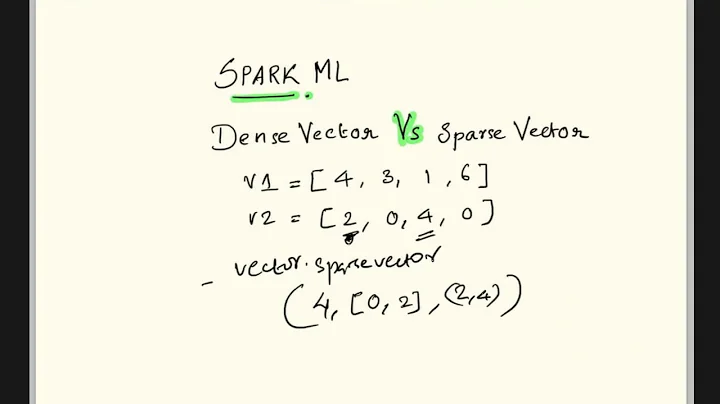Sparse Vector vs Dense Vector
48,898
Solution 1
Unless I have thoroughly misunderstood your doubt, the MLlib data type documentation illustrates this quite clearly:
import org.apache.spark.mllib.linalg.Vector;
import org.apache.spark.mllib.linalg.Vectors;
// Create a dense vector (1.0, 0.0, 3.0).
Vector dv = Vectors.dense(1.0, 0.0, 3.0);
// Create a sparse vector (1.0, 0.0, 3.0) by specifying its indices and values corresponding to nonzero entries.
Vector sv = Vectors.sparse(3, new int[] {0, 2}, new double[] {1.0, 3.0});
Where the second argument of Vectors.sparse is an array of the indices, and the third argument is the array of the actual values in those indices.
Solution 2
Sparse vectors are when you have a lot of values in the vector as zero. While a dense vector is when most of the values in the vector are non zero.
If you have to create a sparse vector from the dense vector you specified, use the following syntax:
import org.apache.spark.mllib.linalg.Vector;
import org.apache.spark.mllib.linalg.Vectors;
Vector sparseVector = Vectors.sparse(4, new int[] {1, 3}, new double[] {3.0, 4.0});
Related videos on Youtube
Comments
-
 Anoop Toffy about 4 years
Anoop Toffy about 4 yearsHow to create
SparseVectorand dense Vector representationsif the
DenseVectoris:denseV = np.array([0., 3., 0., 4.])What will be the Sparse Vector representation ?
-
Nick Chammas over 7 yearsFor those who read the title of "Sparse Vector vs Dense Vector" and were looking for an explanation of when to use which, this answer has the information you're looking for.
-
-
 Anoop Toffy almost 9 yearsOh, I was not passing the right count of indices. SparseV = SparseVector(4, [0, 1, 2, 3], [0., 3., 0., 4.])
Anoop Toffy almost 9 yearsOh, I was not passing the right count of indices. SparseV = SparseVector(4, [0, 1, 2, 3], [0., 3., 0., 4.]) -
 Anoop Toffy almost 9 yearswhat is the significance of a dot after number ie 1. ?
Anoop Toffy almost 9 yearswhat is the significance of a dot after number ie 1. ? -
Abhinav Sood over 7 yearsThe dot just indicates a floating point type.
1.is equivalent to1.0 -
Chthonic Project almost 5 years@MohitShah (i) It is literally the first code example on the linked documentation, and (ii) the answer also includes the example showing exactly how to create a sparse vector.
![DOT PRODUCT OF TWO SPARSE VECTORS - 3 SOLUTIONS EXPLAINED [PYTHON]](https://i.ytimg.com/vi/sQNN4xKC1mA/hqdefault.jpg?sqp=-oaymwEcCOADEI4CSFXyq4qpAw4IARUAAIhCGAFwAcABBg==&rs=AOn4CLBUSWucW_RBtYu4ycow2Gn5j27Hsw)







